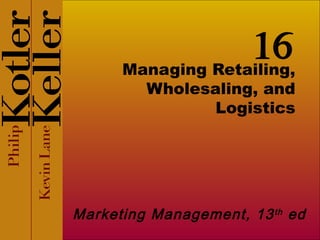More Related Content
Similar to B ch16 managing retailing, wholesaling, and logistics, hara manlagnit (20)
B ch16 managing retailing, wholesaling, and logistics, hara manlagnit
- 1. 16
Managing Retailing,
Wholesaling, and
Logistics
Marketing Management, 13 th ed
- 2. Chapter Questions
What major types of marketing intermediaries
occupy this sector?
What marketing decisions do these marketing
intermediaries make?
What are the major trends with marketing
intermediaries?
Copyright © 2009 Pearson Education, Inc. Publishing as
- 3. What is Retailing?
Retailing includes all the activities involved
in selling goods or services directly to final
consumers for personal, nonbusiness use.
Copyright © 2009 Pearson Education, Inc. Publishing as
- 4. Table 16.1 Major Retailer
Types
Specialty store Discount store
Department store Off-price retailer
Supermarket Superstore
Convenience store Catalog showroom
Copyright © 2009 Pearson Education, Inc. Publishing as
- 5. Nonstore Retailing
Direct selling
Direct marketing
Automatic vending
Buying service
Copyright © 2009 Pearson Education, Inc. Publishing as
- 6. Table 16.2 Major Types of
Corporate
Retail Organizations
Corporate chain store
Voluntary chain
Retailer cooperative
Consumer cooperative
Franchise organization
Merchandising conglomerate
Copyright © 2009 Pearson Education, Inc. Publishing as
- 7. What is a Franchising
System?
A franchising system is a system of
individual franchisees, a tightly knit group of
enterprises whose systematic operations are
planned, directed, and controlled by the
operation’s franchisor.
Copyright © 2009 Pearson Education, Inc. Publishing as
- 8. Characteristics of
Franchises
The franchisor owns a trade or service mark
and licenses it to franchisees in return for
royalty payments
The franchisee pays for the right to be part of
the system
The franchisor provides its franchisees with a
system for doing business
Copyright © 2009 Pearson Education, Inc. Publishing as
- 9. Changes in the
Retail Environment
New retail forms and combinations
Growth of intertype competition
Competition between store-based and non-
store-based retailing
Growth of giant retailers
Decline of middle market retailers
Growing investment in technology
Global profile of major retailers
Copyright © 2009 Pearson Education, Inc. Publishing as
- 10. Retailers’ Marketing
Decisions
Target market
Product assortment
Procurement
Prices
Services
Copyright © 2009 Pearson Education, Inc. Publishing as
- 11. Retailers’ Marketing Decisions
(cont.)
Store atmosphere
Store activities
Communications
Locations
Copyright © 2009 Pearson Education, Inc. Publishing as
- 12. Private Label Brands
Private labels are ubiquitous
Consumer accepts private labels
Private-label buyers come from all
socioeconomic strata
Private labels are not a recessionary
phenomenon
Consumer loyalty shifts from manufacturers
to retailers
Copyright © 2009 Pearson Education, Inc. Publishing as
- 13. Wholesaling Functions
Selling and Transportation
promoting Financing
Buying and Risk bearing
assortment building Market information
Bulk breaking Management
Warehousing services and
counseling
Copyright © 2009 Pearson Education, Inc. Publishing as
- 14. What are
Integrated Logistics Systems?
An integrated logistics system (ILS)
includes materials management, material
flow systems, and physical distribution, aided
by information technology.
Copyright © 2009 Pearson Education, Inc. Publishing as
- 15. Market Logistics Decisions
How should orders be handled?
Where should stock be located?
How much stock should be held?
How should goods be shipped?
Copyright © 2009 Pearson Education, Inc. Publishing as

